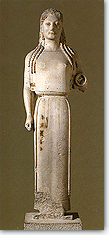







     | |
  |
|
|
The statues of young men and women, which are called kouroi and kores, were funeral monuments or votives to sanctuaries. The kouroi appear in "heroic nudity" and often are related to Apollo, from the sactuaries of whom whole series come (Didyma, Delos, Ptoon). However, exceptions are also found, as in the case of the Sounion kouroi, who are related to Poseidon. The korai always appear dressed, mostly in the sanctuaries of female deities, as in Heraion in Samos and the Athenian Acropolis. Both types have dedicatory inscriptions and, quite often, the signature of their creator. Respectively, when they have been used as funeral monuments they have epigrams related to the dead man or woman, who are always depicted at a young age.
|
If the anatomical features are the vital pointer in evolution for kouroi, the folds of clothing are of the same importance for kores. All clothes were rectangular pieces of textile fixed with buttons, fibulae and pins. The most usual clothing was the Ionic tunic which was often combined with an oblique himation, the epiblema (overcoat) and the peplos. The latter was already apparent fron the middle of the These developments took place most probably in various workshops, but the mobility of the artists, the public exhibition of their works in sanctuaries and cemeteries, the spread of new tools and the exchange of experience among the sculptors that gathered at the marble sources all contributed to the simultaneous development of various local centres. |  |
|
| |
|
Note: Click on picture for short description. | |